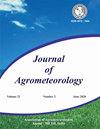Meta analysis on the evaluation and application of DSSAT in South Asia and China: Recent studies and the way forward
Q3 Agricultural and Biological Sciences
引用次数: 1
Abstract
The Decision Support System for Agrotechnology transfer (DSSAT) is a global modelling platform that encompasses crop models for more than 40 different crops. The models have been used extensively throughout the world, including South Asia and China. From the web of science database, we reviewed 205 papers that were published from January 2010 to February 2022 containing examples of the evaluation and application of the DSSAT crop simulation models. In South Asia and China, more than 50 traits and variables were analyzed for various experiments and environmental conditions during this period. The performance of the models was evaluated by comparing the simulated data with the observed data through different statistical parameters. Over the years and across different locations, the DSSAT crop models simulated phenology, growth, yield, and input efficiencies reasonably well with a high coefficient of determination (R2), and Willmott d-index, together with a low root mean square error (RMSE), normalized RMSE (RMSEn), mean error (ME) or percentage error difference. The CERES models for rice, wheat and maize were the most used models, followed by the CROPGRO models for cotton and soybean. Grain yield, anthesis and maturity dates, above ground biomass, and leaf area index were the variables that were evaluated most frequently for the different crop models. The meta-analysis of the data of the most common simulated variables (Anthesis, maturity, leaf area index, grain yield and above ground biomass) for the four commonly used DSSAT models (CERES-Rice, CERES-Wheat, CERES-Maize and CROPGRO-Cotton) showed that the models predicted anthesis with an RMSE of ~2 (CERES-Maize) and -4 days (CERES-Wheat), a normalized RMSE of ~2.5 (CERES-Maize) and -3.8% (CERES-Rice), and a R2 ~ 0.98-0.99. The maturity was predicted with an RMSE~ 3.0 (CERES-Maize)-6.1 days (CROPGRO-Cotton), normalized RMSE~2.3 (CERES-Wheat)-5.0% (CERES-Rice) and R2 ~ 0.90-0.99. The leaf area index was predicted with an RMSE~ 0.3-0.7, normalized RMSE~6 (CROPGRO-Cotton)-16% (CERES-Maize) and R2 ~ 0.75-0.98. The model performance for simulating grain yield was best with CROPGRO-cotton with a normalized RMSE of 4.4%, RMSE of 138.8 kg and R2 of 0.99. The lowest R2 and highest RMSEn was found for CERES-Wheat. Among all the variables that were evaluated, above ground biomass was least accurately simulated with a RMSEn as high as 18% and R2 as small as 0.50 by CERES-Wheat. The models were used for studying the crop response under various soil, weather, and management conditions. The review will be helpful to identify the research gap in the use of crop models for different crops in South Asia and China. It can also aid scientists to target their research for specific applications to address food and nutrition security based on sustainable management practices.南亚和中国DSSAT评估和应用的Meta分析:近期研究和发展方向
农业技术转让决策支持系统(DSSAT)是一个全球建模平台,包含40多种不同作物的作物模型。这些模型已在世界各地广泛使用,包括南亚和中国。从web of science数据库中,我们回顾了2010年1月至2022年2月期间发表的205篇论文,其中包含DSSAT作物模拟模型的评估和应用实例。在南亚和中国,对这一时期的各种试验和环境条件进行了50多个性状和变量分析。通过不同的统计参数,将模拟数据与观测数据进行比较,评价模型的性能。多年来,在不同的地点,DSSAT作物模型具有较高的决定系数(R2)和Willmott d指数,以及较低的均方根误差(RMSE)、归一化RMSE (RMSEn)、平均误差(ME)或百分比误差差,可以较好地模拟物候、生长、产量和投入效率。使用最多的是水稻、小麦和玉米的CERES模型,其次是棉花和大豆的CROPGRO模型。籽粒产量、花期和成熟期、地上生物量和叶面积指数是不同作物模型中最常评估的变量。对4个常用DSSAT模型(CERES-Rice、CERES-Wheat、CERES-Maize和CROPGRO-Cotton)的最常见模拟变量(开花、成熟度、叶面积指数、籽粒产量和地上生物量)数据进行meta分析,结果表明,模型预测开花的RMSE为~2 (CERES-Maize)和-4 d (CERES-Wheat),归一化RMSE为~2.5 (CERES-Maize)和-3.8% (CERES-Rice), R2为~ 0.98 ~ 0.99。预测成熟度的RMSE为3.0 (ceres -玉米)-6.1天(cropgr -棉花),归一化RMSE为2.3 (ceres -小麦)-5.0% (ceres -水稻),R2为0.90 ~ 0.99。预测叶面积指数的RMSE为0.3 ~ 0.7,归一化RMSE为6 (CROPGRO-Cotton) ~ 16% (CERES-Maize), R2为0.75 ~ 0.98。以cropgro -棉花为模型模拟籽粒产量效果最好,归一化RMSE为4.4%,RMSE为138.8 kg, R2为0.99。CERES-Wheat的R2最低,RMSEn最高。在所有被评估的变量中,CERES-Wheat对地上生物量的模拟精度最低,RMSEn高达18%,R2小至0.50。这些模型用于研究作物在不同土壤、天气和管理条件下的响应。这一综述将有助于确定南亚和中国在使用不同作物的作物模型方面的研究差距。它还可以帮助科学家将他们的研究定位于特定的应用,以解决基于可持续管理实践的粮食和营养安全问题。
本文章由计算机程序翻译,如有差异,请以英文原文为准。
求助全文
约1分钟内获得全文
求助全文
来源期刊

Journal of Agrometeorology
农林科学-农艺学
CiteScore
1.40
自引率
0.00%
发文量
95
审稿时长
>12 weeks
期刊介绍:
The Journal of Agrometeorology (ISSN 0972-1665) , is a quarterly publication of Association of Agrometeorologists appearing in March, June, September and December. Since its beginning in 1999 till 2016, it was a half yearly publication appearing in June and December. In addition to regular issues, Association also brings out the special issues of the journal covering selected papers presented in seminar symposia organized by the Association.
 求助内容:
求助内容: 应助结果提醒方式:
应助结果提醒方式:


